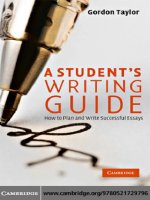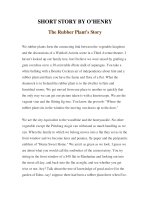A children’s story The Tortoises’ Picnic
Bạn đang xem bản rút gọn của tài liệu. Xem và tải ngay bản đầy đủ của tài liệu tại đây (131.78 KB, 7 trang )
Text © Sagrario Salaberri Design and illustration © Macmillan Publishers Ltd 1995
7
A children’s story
The Tortoises’ Picnic
This story will probably be new to the class, but it has a lot of the basic
characteristics of many children’s stories: the characters are animals, there is a lot of
natural repetition of many elements, it is easy to illustrate and act out, there is a
funny and surprising ending and the class will recognise the nouns and actions in the
story. You can use this story when the class is working on any of the following areas:
family, food, weather, time, animals.
Activity 1
First, get the class to produce the visuals that are going to be used in the story by
giving them the following instructions.
Draw the three tortoises. (mother, father, baby)
Draw the food. (sandwiches, chocolates, ice-creams, fruit, orange squash or other
examples of food suitable for your class)
Draw the weather symbols. (flowers for spring, sun for summer, clouds and rain
for autumn, snow for winter)
Draw the trees.
Draw a basket.
Draw a tablecloth.
Activity 2
The aim of this TPR (Total Physical Response) activity is to check that the class
understand the basic vocabulary. The class should respond in a physical way by
actually carrying out the instructions.
Show me father tortoise.
Put him on the table.
Put mother tortoise next to father tortoise.
You are hungry.
Eat a sandwich.
You don’t feel hungry.
Take the chocolates.
Put the chocolates into the basket.
Take them out.
Put them on the tablecloth.
1
Before you
read
8
Text © Sagrario Salaberri Design and illustration © Macmillan Publishers Ltd 1995
CHAPTER 1 A children’s story: The Tortoises’ Picnic
Activity 3
Ask the class in their own language if they know the word picnic and then get them
to tell you all the words they associate with it. Accept any of their suggestions,
repeating each word clearly in context as you go along. For example: Oh! So you go
to the country with your family. And you take food and chairs and a tablecloth….
Note down the vocabulary suggested by the class in the form of a diagram or word
map so that the class has a record of what they know about the subject and what
they are going to hear later in the story itself.
Start to tell the story and put up the pictures of the characters on the board as they
are mentioned. Bear in mind the following suggestions:
1 Use gesture, mime, actions or movements to help the class understand the
situations in the story. For example, put the food in the basket, take it out and put
it on the tablecloth, shake the basket to try and find the tin-opener, make baby
tortoise disappear behind the trees, mime being cold or hot, etc.
2 Put the pictures on the board (or wherever else you have decided to display them)
in the same order as in the story. This helps the class to follow the action of the
story in space and time.
3 The pictures of the main characters – the tortoises – are up on the board when
you start to tell the story. Use these pictures to help the class understand the
dialogues between the characters which follow in the story. So that the class can
tell who is speaking in each dialogue, position yourself in front of the character
who is speaking. Alternatively, turn to the left or right depending on the position
of the character who is being talked to.
4 It is important to use mime to help the class understand expressions of surprise,
disagreement, agreement, and to show when someone is giving orders. It is also
useful in helping the class understand sentences such as they walked and walked
and walked, they waited, waited and waited or they got really hungry.
While you
read
Text © Sagrario Salaberri Design and illustration © Macmillan Publishers Ltd 1995
9
CHAPTER 1 A children’s story: The Tortoises’ Picnic
T
HE
T
ORTOISES
’ P
ICNIC
Once upon a time there were three tortoises – a father, a mother and a
baby. One beautiful spring day, they decided to go for a picnic. They got
tins of salmon, and sandwiches, and chocolates, and ice-creams, and
fruit, and orange squash and put everything in their baskets and after
three months they were ready. It was summer and it was sunny and very
hot, and they set out carrying their baskets.
They walked and walked and walked and after three months they sat
down and had a rest. They were a mile from home. It was autumn and
it was cloudy and raining. They set out again and walked and walked
and walked and in three months they reached the picnic place. They
were two miles from home. It was winter and it was snowing and very
cold. They unpacked their baskets and spread out the cloth, and
arranged the food on it and it looked lovely.
Then Mother tortoise looked into the baskets. She turned them all
upside down and shook them, but they were empty.
At last she said, ‘We’ve forgotten the tin-opener!’
They looked at each other and at last Father tortoise said, ‘Baby,
you’ll have to go back for it.’
‘What!’ said the baby. ‘Me! Go back all that long way!’
‘We can’t start without a tin-opener. We’ll wait for you,’ said Father
tortoise.
‘Do you promise that you won’t touch a thing till I come back?’ Baby
said.
‘Yes, we promise,’ they said, and Baby disappeared behind the trees.
And Father and Mother waited. They waited and waited and waited
and a whole year passed and they got really hungry.
‘Don’t you think we could have just one sandwich each?’ said Mother
tortoise.
‘No,’ said Father tortoise. ‘We promised. We must wait till he comes
back.’
So they waited and waited and waited, and another year passed, and
they got really hungry.
‘It’s six years now. Let’s just have one sandwich while we’re waiting,’
said Father tortoise.
They picked up the sandwiches, but just as they were going to eat
them, a little voice said, ‘Aha! I knew you would cheat.’ And Baby
tortoise popped his head out of a bush. ‘It’s a good thing I didn’t go
back for the tin-opener,’ he said.
10
Text © Sagrario Salaberri Design and illustration © Macmillan Publishers Ltd 1995
CHAPTER 1 A children’s story: The Tortoises’ Picnic
Activity 1
To check understanding of the basic content of the story, it is a good idea, particularly
with beginners, to ask some questions with short Yes/No answers. For example:
Are they going for a picnic? Does baby go back for the tin-opener?
Have they got the tin-opener? After six years are they hungry?
With slightly higher levels, you can ask or questions, such as:
Are they tortoises or snakes? Are they carrying baskets or bags?
Are they going for a picnic or a walk? Are they hungry or thirsty?
With higher level classes, you can ask more complex questions, including Wh-
questions which require more complete answers. For example:
Who are the characters? What are they carrying in their baskets?
Where are they going? What have they forgotten?
Activity 2
Another way of exploiting the story is to tell it wrongly by substituting new words for
what you think is key vocabulary. The class must say Stop! every time they hear a
mistake and then provide the correct word. For example:
Once upon a time there were three frogs, a mother, a father and a
grandfather. One beautiful winter day they decided to go for a walk…
Activity 1
This activity helps to check the class’s understanding of the sequence of the story.
Divide the story into six parts, summarise the key moments from each part and write
them on six separate strips of paper. Get the class to stand in random order in
groups of six. They have to reconstruct the story in the correct order, each reading
their part and saying if it goes before or after the parts the rest of the class have got.
Check the class understand the basic concepts of before and after by asking
questions such as Louise, do you go after Alex? The groups themselves can report
back to the class at the end of the activity, for example, I go after Paul and before
Laura. With beginners, you can use pictures drawn by the class instead of sentences.
Put them up on the board in the correct order as you read the story. The pictures can
show, for example:
1 The three tortoises and the basket
2 The food on the tablecloth in the snow
3 Mother tortoise emptying the basket
4 Baby tortoise going off to find the tin-opener
5 Mother and father tortoise waiting
6 Mother and father tortoise about to eat a sandwich while baby tortoise’s head
appears between the bushes
After you
read
Text © Sagrario Salaberri Design and illustration © Macmillan Publishers Ltd 1995
11
CHAPTER 1 A children’s story: The Tortoises’ Picnic
Activity 2
Get the class to make simple puppets of the characters and objects in the story or
give out different parts of the story written on card (tortoises, food, seasons, etc).
Get the class to hold up their puppet or card as the corresponding character or part
is mentioned in the story. Each pupil should carry out the actions and gestures of the
character or part they represent. Role play activities help to improve the general
understanding of the story and the aural comprehension of certain elements in
particular.
Activity 3
This activity aims to help the class memorise parts of the story and to practise
rhythm and intonation. The process of memorising language is helped if the
sentences are written in an imaginary space. By showing movement, actions and the
physical location of language, the class can start to view language as a concrete,
rather than abstract thing. Pretend to be surrounded by four imaginary walls, one in
front of you, one behind and one to the left and right of you. You can also show the
class through gesture that it is impossible to pass through the walls. Start to write a
sentence on one wall, saying it out loud as you write. For example, They set out for
a picnic. Then mime rubbing it out. Repeat this several times and then get the class
to tell you the sentence as you begin to write it. Do this with three other sentences
on the three other imaginary walls. For example:
And they got really hungry. And they got tins of salmon.
They put food in a basket.
These four sentences have the same number of stressed syllables and the same
sentence stress. This means that when they are said together they produce a rhythm
which the class can mark by clapping their hands. Get the class to act out the
sentences which contain repetition and which are used as a link to other sentences.
For example:
And they walked and walked and walked.
And they waited and waited and waited.
The class will find memorising the lines and the intonation easier as you repeat the
writing of the sentences on the walls, speeding up the process each time.
You can create ‘poems’ from any story following this technique, provided you make
sure that the sentences you select have the same stress, rhythm and number of
stressed syllables.
Activity 4
This activity practises simple maths. Show an OHT or give out copies of the picture
of the food and prices and ask appropriate questions.









